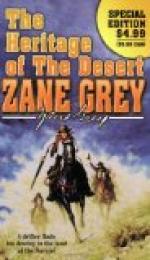“They’re spread now,” said August. “Mescal drives them on every little while and Piute goes ahead to pick out the best browse. Watch the dog, Jack; he’s all but human. His mother was a big shepherd dog that I got in Lund. She must have had a strain of wild blood. Once while I was hunting deer on Coconina she ran off with timber wolves and we thought she was killed. But she came back, and had a litter of three puppies. Two were white, the other black. I think she killed the black one. And she neglected the others. One died, and Mescal raised the other. We called him Wolf. He loves Mescal, and loves the sheep, and hates a wolf. Mescal puts a bell on him when she is driving, and the sheep know the bell. I think it would be a good plan for her to tie something red round his neck—a scarf, so as to keep you from shooting him for a wolf.”
Nimble, alert, the big white dog was not still a moment. His duty was to keep the flock compact, to head the stragglers and turn them back; and he knew his part perfectly. There was dash and fire in his work. He never barked. As he circled the flock the small Navajo sheep, edging ever toward forbidden ground, bleated their way back to the fold, the larger ones wheeled reluctantly, and the old belled rams squared themselves, lowering their massive horns as if to butt him. Never, however, did they stand their ground when he reached them, for there was a decision about Wolf which brooked no opposition. At times when he was working on one side a crafty sheep on the other would steal out into the thicket. Then Mescal called and Wolf flashed back to her, lifting his proud head, eager, spirited, ready to take his order. A word, a wave of her whip sufficed for the dog to rout out the recalcitrant sheep and send him bleating to his fellows.
“He manages them easily now,” said Naab, “but when the lambs come they can’t be kept in. The coyotes and wolves hang out in the thickets and pick up the stragglers. The worst enemy of sheep, though, is the old grizzly bear. Usually he is grouchy, and dangerous to hunt. He comes into the herd, kills the mother sheep, and eats the milk-bag—no more! He will kill forty sheep in a night. Piute saw the tracks of one up on the high range, and believes this bear is following the flock. Let’s get off into the woods some little way, into the edge of the thickets—for Piute always keeps to the glades—and see if we can pick off a few coyotes.”
August cautioned Jack to step stealthily, and slip from cedar to cedar, to use every bunch of sage and juniper to hide his advance.
“Watch sharp, Jack. I’ve seen two already. Look for moving things. Don’t try to see one quiet, for you can’t till after your eye catches him moving. They are gray, gray as the cedars, the grass, the ground. Good! Yes, I see him, but don’t shoot. That’s too far. Wait. They sneak away, but they return. You can afford to make sure. Here now, by that stone—aim low and be quick.”




